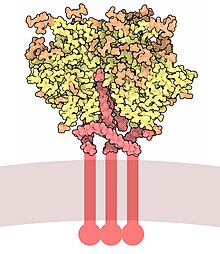
Back بروتين سكري 120 Arabic Gp120 Catalan Gp120 (HIV) German Proteína superficial gp120 Spanish Gp120 French Gp120 ID Gp120 Italian Gp120 (HIV) Japanese Gp120 Dutch Gp120 Portuguese
| Envelope glycoprotein gp120 | |||||||||
|---|---|---|---|---|---|---|---|---|---|
| Identifiers | |||||||||
| Symbol | GP120 | ||||||||
| Pfam | PF00516 | ||||||||
| InterPro | IPR000777 | ||||||||
| SCOP2 | 1gc1 / SCOPe / SUPFAM | ||||||||
| |||||||||
Envelope glycoprotein GP120 (or gp120) is a glycoprotein exposed on the surface of the HIV envelope. It was discovered by Professors Tun-Hou Lee and Myron "Max" Essex of the Harvard School of Public Health in 1984.[1] The 120 in its name comes from its molecular weight of 120 kDa. Gp120 is essential for virus entry into cells as it plays a vital role in attachment to specific cell surface receptors. These receptors are DC-SIGN,[2] Heparan Sulfate Proteoglycan[3] and a specific interaction with the CD4 receptor,[4] particularly on helper T-cells. Binding to CD4 induces the start of a cascade of conformational changes in gp120 and gp41 that lead to the fusion of the viral membrane with the host cell membrane. Binding to CD4 is mainly electrostatic although there are van der Waals interactions and hydrogen bonds.[5]

Gp120 is coded by the HIV env gene, which is around 2.5 kb long and codes for around 850 amino acids.[6] The primary env product is the protein gp160, which gets cleaved to gp120 (~480 amino acids) and gp41 (~345 amino acids) in the endoplasmatic reticulum by the cellular protease furin.[7] The crystal structure of core gp120 shows an organization with an outer domain, an inner domain with respect to its termini and a bridging sheet. Gp120 is anchored to the viral membrane, or envelope, via non-covalent bonds with the transmembrane glycoprotein, gp41. Three gp120s and gp41s combine in a trimer of heterodimers to form the envelope spike,[8] which mediates attachment to and entry into the host cell.
- ^ Sodroski, Joseph; Patarca, Roberto; Perkins, Dennis; Briggs, Debra; Tun-Hou, Lee; Essex, Myron; Coligan, John; Wong-Staal, Flossie; Gallo, Robert C. (1984). "Sequence of the Envelope Glycoprotein Gene of Type II Human T Lymphotropic Virus". Science. 225 (4660): 421–424. Bibcode:1984Sci...225..421S. doi:10.1126/science.6204380. PMID 6204380.
- ^ Curtis BM, Scharnowske S, Watson AJ (September 1992). "Sequence and expression of a membrane-associated C-type lectin that exhibits CD4-independent binding of human immunodeficiency virus envelope glycoprotein gp120". Proc. Natl. Acad. Sci. U.S.A. 89 (17): 8356–60. Bibcode:1992PNAS...89.8356C. doi:10.1073/pnas.89.17.8356. PMC 49917. PMID 1518869.
- ^ de Witte L, Bobardt M, Chatterji U, Degeest G, David G, Geijtenbeek TB, Gallay P (December 2007). "Syndecan-3 is a dendritic cell-specific attachment receptor for HIV-1". Proc. Natl. Acad. Sci. U.S.A. 104 (49): 19464–9. Bibcode:2007PNAS..10419464D. doi:10.1073/pnas.0703747104. PMC 2148312. PMID 18040049.
- ^ Dalgleish AG, Beverley PC, Clapham PR, Crawford DH, Greaves MF, Weiss RA (1984). "The CD4 (T4) antigen is an essential component of the receptor for the AIDS retrovirus". Nature. 312 (5996): 763–7. Bibcode:1984Natur.312..763D. doi:10.1038/312763a0. PMID 6096719. S2CID 4349809.
- ^ Korkut, A; Hendrickson, WA (2012). "Structural Plasticity and Conformational Transitions of HIV Envelope Glycoprotein gp120". PLOS ONE. 7 (12): e52170. Bibcode:2012PLoSO...752170K. doi:10.1371/journal.pone.0052170. PMC 3531394. PMID 23300605.
- ^ Kuiken, C., Leitner, T., Foley, B., et al. (2008). "HIV Sequence Compendium", Los Alamos National Laboratory.
- ^ Hallenberger S, Bosch V, Angliker H, Shaw E, Klenk HD, Garten W (November 1992). "Inhibition of furin-mediated cleavage activation of HIV-1 glycoprotein gp160". Nature. 360 (6402): 358–61. Bibcode:1992Natur.360..358H. doi:10.1038/360358a0. PMID 1360148. S2CID 4306605.
- ^ Zhu P, Winkler H, Chertova E, Taylor KA, Roux KH (November 2008). "Cryoelectron tomography of HIV-1 envelope spikes: further evidence for tripod-like legs". PLOS Pathog. 4 (11): e1000203. doi:10.1371/journal.ppat.1000203. PMC 2577619. PMID 19008954.